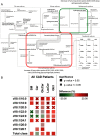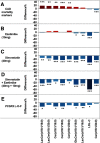Molecular lipids identify cardiovascular risk and are efficiently lowered by simvastatin and PCSK9 deficiency
- PMID: 24243630
- PMCID: PMC3928964
- DOI: 10.1210/jc.2013-2559
Molecular lipids identify cardiovascular risk and are efficiently lowered by simvastatin and PCSK9 deficiency
Abstract
Context: Coronary artery disease (CAD) is among the leading causes of mortality and morbidity worldwide. Traditional risk markers explain only a proportion of total cardiovascular risk. Thus, development and improvement of early diagnostic strategies and targeted initiation of preventive measures would be of great benefit.
Objective: We aimed to identify molecular lipids that are associated with fatal outcome of CAD patients. Furthermore, the effect of different lipid-lowering drugs on novel risk lipids was evaluated.
Methods: Serum samples of 445 CAD subjects participating in a long-term follow-up of the Ludwigshafen Risk and Cardiovascular Health (LURIC) study were analyzed. In addition, samples obtained from a separate randomized parallel three-group study of subjects treated with simvastatin (n=24), ezetimibe (n=24), or their combination (n=24) were studied. Furthermore, samples from the LURIC participants with a loss-of-function mutation (R46L) in the PCSK9 gene (n=19) were analyzed and compared with major allele carriers (n=868).
Results: Distinct ceramide species were significantly associated with the fatal outcome of CAD patients. Simvastatin lowered plasma ceramides broadly by about 25%, but no changes in ceramides were observed in the ezetimibe group. PCSK9 deficiency was significantly associated (-13%) with lowered low-density lipoprotein cholesterol accompanied by a significant 20% reduction in CAD outcome risk-related ceramides.
Conclusions: These data suggest that distinct ceramides associate significantly with CAD outcome independently of traditional risk factors and that the mechanism of lipid lowering is important.
Figures




References
-
- Sachdeva A, Cannon CP, Deedwania PC, et al. Lipid levels in patients hospitalized with coronary artery disease: an analysis of 136 905 hospitalizations in Get With The Guidelines. Am Heart J. 2009;157:111–117.e112 - PubMed
-
- Stubiger G, Aldover-Macasaet E, Bicker W, et al. Targeted profiling of atherogenic phospholipids in human plasma and lipoproteins of hyperlipidemic patients using MALDI-QIT-TOF-MS/MS. Atherosclerosis. 2012;224:177–186 - PubMed
Publication types
MeSH terms
Substances
LinkOut - more resources
Full Text Sources
Other Literature Sources
Medical
Miscellaneous

